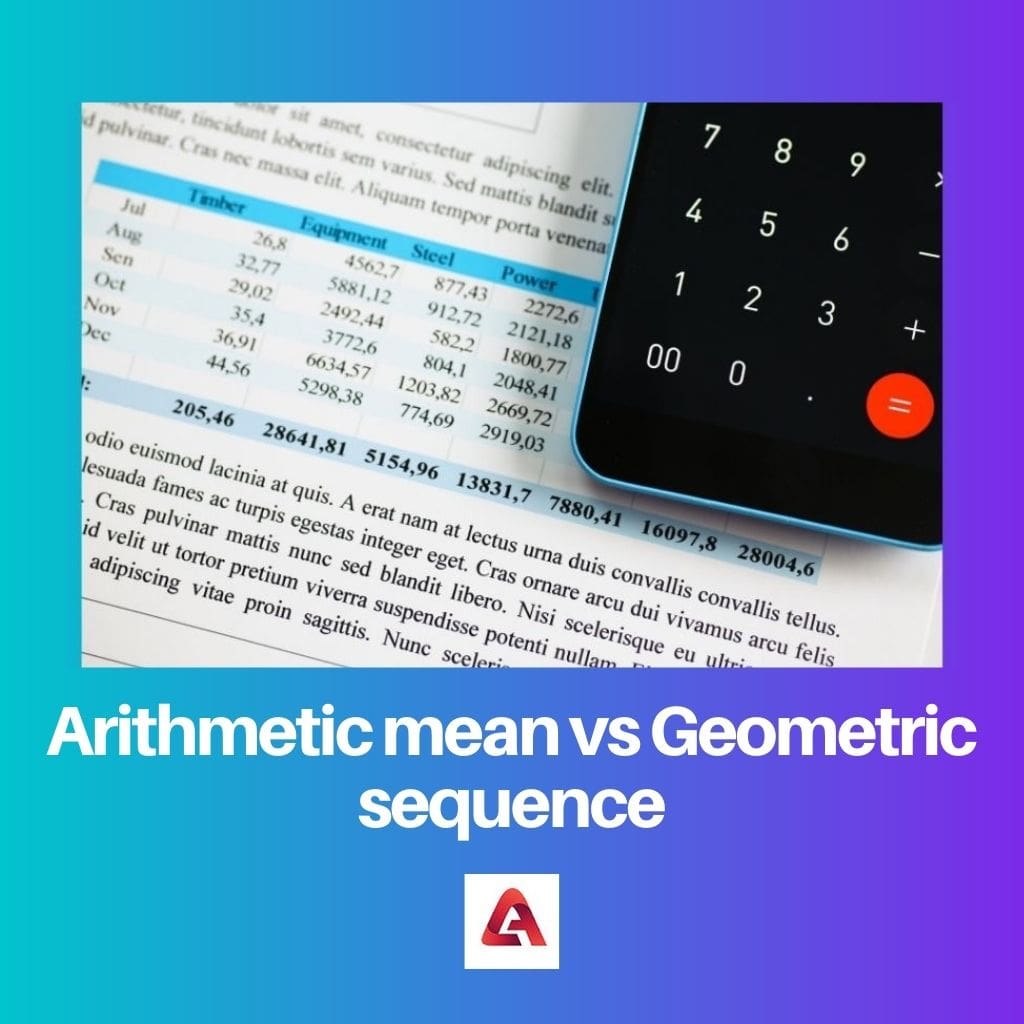The arithmetic mean and geometric sequence is essential for calculating financial and economic growth. Stock markets, increments, population growth, etc., are the critical areas that use these terms widely.
Key Takeaways
- The arithmetic mean, also known as the average, is a measure of central tendency calculated by summing the values in a dataset and dividing by the number of values; a geometric sequence is an ordered list of numbers in which each term after the first is found by multiplying the previous time by a fixed, non-zero number called the common ratio.
- The arithmetic mean is a single value representing the center of a dataset, while a geometric sequence is a series of numbers following a specific multiplication pattern.
- Both the arithmetic mean and geometric sequences are mathematical concepts. Still, the arithmetic mean is a measure of central tendency used in statistics and data analysis. In contrast, geometric sequences are used in various mathematical applications, such as exponential growth and decay models.
Arithmetic Mean vs Geometric Sequence
Arithmetic mean is the average of a set of numbers obtained by dividing the sum of numbers by their count and is a single value that represents the center of the set of numbers. Geometric sequence is a sequence of numbers where each term is found by multiplying the previous term by a constant ratio.

The Arithmetic mean, or the average, is the collection of numbers divided by the count of numbers. In contrast, the Geometric sequence is the collection of terms obtained by dividing or multiplying the constant time.
A sequence is the structured collection of terms in a repetitive pattern, whereas ‘arithmetic mean’ is the average derived out of that sequence of numbers. The ‘arithmetic mean’ and ‘geometric sequence’ are the mathematical terms used to find this systematic organization of words.
The arithmetic mean is the average of the numbers in a sequence where the difference between two consecutive terms might or might not be separated by a constant number. When these terms are present in a definite ratio, the ratio is determined by the geometric sequence known as a standard ratio.
Comparison Table
| Parameters of Comparison | Arithmetic mean | Geometric sequence |
|---|---|---|
| Definition | The arithmetic mean is the average of the collection of numbers in a given sequence. | The geometric sequence is the collection of terms with a constant difference in the ratio of two consecutive terms. |
| Determined by | It can be determined by dividing the sum of the collection of numbers by the total count of numbers. | It can be determined by multiplying or dividing a constant by the preceding term. |
| Form | This is expressed as an average of the collection. | This sequence is expressed in the exponential form. |
| Common formula | A= (a1 + a2+ .. + an)/n (where a is the 1st digit and n is the total number of digits we can find the mean A through this formula) | tn = t1 . r(n – 1) (where r is the standard ratio and, tn is the nth term, t1 is the first term) |
| Uses | The arithmetic mean or the average is used in observational and experimental studies to get a brief idea of the large sample size because the mean becomes the data’s central tendency. | A geometric sequence is used in various sectors, such as financial and economic sectors, to calculate the growth rates, savings, costs, etc. |
What is Arithmetic Mean?
The arithmetic mean is the average of the sequence of terms that may or may not be separated by the common difference. To find the standard, we divide the sum of a collection of the terms by the total number present.
For the experimental research and the observational studies, the mean can be calculated as the sum of the total number of observations divided by the number of observations, which is written as:
Arithmetic Mean = (sum of all the observations)/(total number of observations)
When the data is present in a sequence, then the average of any sequence can be determined by the given formula:
A= (a1 + a2+ .. + an)/n
‘A’ is the average or the arithmetic mean, ‘a’ is the 1st term, and ‘n’ is the total number of terms in the collection.
For example, we have to find the arithmetic mean of the sequence 2, 4, 6, 8, 10
This can be quickly done by the mentioned formula as (2+4+6+8+10)/5= 6
The arithmetic mean has applications in daily life when observed. The average is meaningful in anthropology, history, statistics, calculating per capita income, etc. The arithmetic mean has certain limitations because it is just the approximate value, not the exact value.

What is Geometric Sequence?
A geometric sequence is a sequence of numbers with consecutive terms in a standard ratio. The line obtained is called geometric when the progression is multiplied or divided by the same non-zero number.
This progression can be depicted as a, ar, ar2, ar3, ar 4 and so on (where a is the 1st term and r is the common ratio)
For example, 3, 9, 27, 81, _ _ _
The geometric sequence is expressed in the exponential form by the formula: tn = t1. r(n – 1) (where tn is the nth term, t1 is the first term, and d is the standard ratio)
Geometrical sequences seem more complex to figure out than the arithmetic mean. Still, they have numerous uses in day-to-day work, such as calculating growth rates, stock markets, interest rates, etc.

Main Differences Between Arithmetic Mean and Geometric Sequence
- The arithmetic mean is the average of the collection of terms by dividing the sum by the number of given words, whereas geographic sequence is the sequence of consecutive times with a standard ratio.
- The arithmetic mean can be obtained by adding the collection of terms and dividing them by the number of terms present. The geometric sequence is obtained by multiplying or dividing the constant non-zero term from the preceding number.
- The arithmetic mean is the central tendency of the data set, whereas the geometric sequence is exponential in variation.
- The arithmetic mean is used mainly in observational studies, experiments, etc., whereas geometric sequence is used in the stock markets to calculate savings, cost, etc.
- The arithmetic mean is also used to size down the significant data to get the approximate hint of the results, whereas geometric sequence is the sequence of exact data. The ‘arithmetic mean,’ therefore, can’t always provide the exact results.






